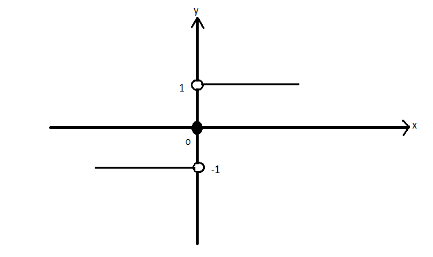
Let $f(x) = {\mathop{\rm sgn}} ({\mathop{\rm sgn}} (x))$ . Then $\mathop {\lim }\limits_{x \to 0} f(x)$ is:-
A) 1
B) 2
C) 0
D) Does not exist
Answer
576.6k+ views
Hint: Here in this question the concept of signum function and limit will get used. Definition of signum function and limit existence is as follows:-
Signum function or sign function is defined as f(x) = $\dfrac{{\left| x \right|}}{x};x \ne 0$
$f(x) = \left\{ {\begin{array}{*{20}{c}}
{ - 1,x < 0}\\
{0,x = 0}\\
{1,x > 0}
\end{array}} \right\}$ is called a signum function.
Limit of a function exists when $\mathop {\lim }\limits_{x \to {0^ - }} f(x)\mathop { = \lim }\limits_{x \to {0^ + }} f(x) = L$ which is left hand side limit and right hand side limit and $L = \mathop {\lim }\limits_{x \to 0} f(x)$
Complete step-by-step answer:
As the given function is $f(x) = {\mathop{\rm sgn}} ({\mathop{\rm sgn}} (x))$ so, first of all we will find the left hand side limit.
$ \Rightarrow \mathop {\lim }\limits_{x \to {0^ - }} f(x) = {\mathop{\rm sgn}} ({\mathop{\rm sgn}} ({0^ - }))$
Now from the definition of signum function we know that ${\mathop{\rm sgn}} (x) = - 1$ when $x < 0$therefore we will get,
$ \Rightarrow \mathop {\lim }\limits_{x \to {0^ - }} f(x) = {\mathop{\rm sgn}} ( - 1)$
For all values less than 0 signum functions will give -1
$ \Rightarrow \mathop {\lim }\limits_{x \to {0^ - }} f(x) = - 1$
Now we will find the right hand side limit.
$ \Rightarrow \mathop {\lim }\limits_{x \to {0^ + }} f(x) = {\mathop{\rm sgn}} ({\mathop{\rm sgn}} ({0^ + }))$
Now from the definition of signum function we know that ${\mathop{\rm sgn}} (x) = 1$ when $x > 0$therefore we will get,
$ \Rightarrow \mathop {\lim }\limits_{x \to {0^ + }} f(x) = {\mathop{\rm sgn}} (1)$
For all values greater than 0 signum function will give +1
$ \Rightarrow \mathop {\lim }\limits_{x \to {0^ + }} f(x) = 1$
As we can see that left hand limit is not equal to the right hand limit therefore limit does not exist so the correct option is (D)
Note: Students may likely to make mistake while putting value of signum function so here below graphical approach for signum function is mentioned:-

Here we can see that for x greater than zero the value of the function is 1 and for x less than zero the value of function is -1 and at x equal to zero value is zero. Also at points 1 and -1 there is a point of discontinuity as the graph breaks at these points.
Signum function or sign function is defined as f(x) = $\dfrac{{\left| x \right|}}{x};x \ne 0$
$f(x) = \left\{ {\begin{array}{*{20}{c}}
{ - 1,x < 0}\\
{0,x = 0}\\
{1,x > 0}
\end{array}} \right\}$ is called a signum function.
Limit of a function exists when $\mathop {\lim }\limits_{x \to {0^ - }} f(x)\mathop { = \lim }\limits_{x \to {0^ + }} f(x) = L$ which is left hand side limit and right hand side limit and $L = \mathop {\lim }\limits_{x \to 0} f(x)$
Complete step-by-step answer:
As the given function is $f(x) = {\mathop{\rm sgn}} ({\mathop{\rm sgn}} (x))$ so, first of all we will find the left hand side limit.
$ \Rightarrow \mathop {\lim }\limits_{x \to {0^ - }} f(x) = {\mathop{\rm sgn}} ({\mathop{\rm sgn}} ({0^ - }))$
Now from the definition of signum function we know that ${\mathop{\rm sgn}} (x) = - 1$ when $x < 0$therefore we will get,
$ \Rightarrow \mathop {\lim }\limits_{x \to {0^ - }} f(x) = {\mathop{\rm sgn}} ( - 1)$
For all values less than 0 signum functions will give -1
$ \Rightarrow \mathop {\lim }\limits_{x \to {0^ - }} f(x) = - 1$
Now we will find the right hand side limit.
$ \Rightarrow \mathop {\lim }\limits_{x \to {0^ + }} f(x) = {\mathop{\rm sgn}} ({\mathop{\rm sgn}} ({0^ + }))$
Now from the definition of signum function we know that ${\mathop{\rm sgn}} (x) = 1$ when $x > 0$therefore we will get,
$ \Rightarrow \mathop {\lim }\limits_{x \to {0^ + }} f(x) = {\mathop{\rm sgn}} (1)$
For all values greater than 0 signum function will give +1
$ \Rightarrow \mathop {\lim }\limits_{x \to {0^ + }} f(x) = 1$
As we can see that left hand limit is not equal to the right hand limit therefore limit does not exist so the correct option is (D)
Note: Students may likely to make mistake while putting value of signum function so here below graphical approach for signum function is mentioned:-

Here we can see that for x greater than zero the value of the function is 1 and for x less than zero the value of function is -1 and at x equal to zero value is zero. Also at points 1 and -1 there is a point of discontinuity as the graph breaks at these points.
Recently Updated Pages
Why are manures considered better than fertilizers class 11 biology CBSE

Find the coordinates of the midpoint of the line segment class 11 maths CBSE

Distinguish between static friction limiting friction class 11 physics CBSE

The Chairman of the constituent Assembly was A Jawaharlal class 11 social science CBSE

The first National Commission on Labour NCL submitted class 11 social science CBSE

Number of all subshell of n + l 7 is A 4 B 5 C 6 D class 11 chemistry CBSE

Trending doubts
What is meant by exothermic and endothermic reactions class 11 chemistry CBSE

10 examples of friction in our daily life

One Metric ton is equal to kg A 10000 B 1000 C 100 class 11 physics CBSE

1 Quintal is equal to a 110 kg b 10 kg c 100kg d 1000 class 11 physics CBSE

Difference Between Prokaryotic Cells and Eukaryotic Cells

What are Quantum numbers Explain the quantum number class 11 chemistry CBSE




